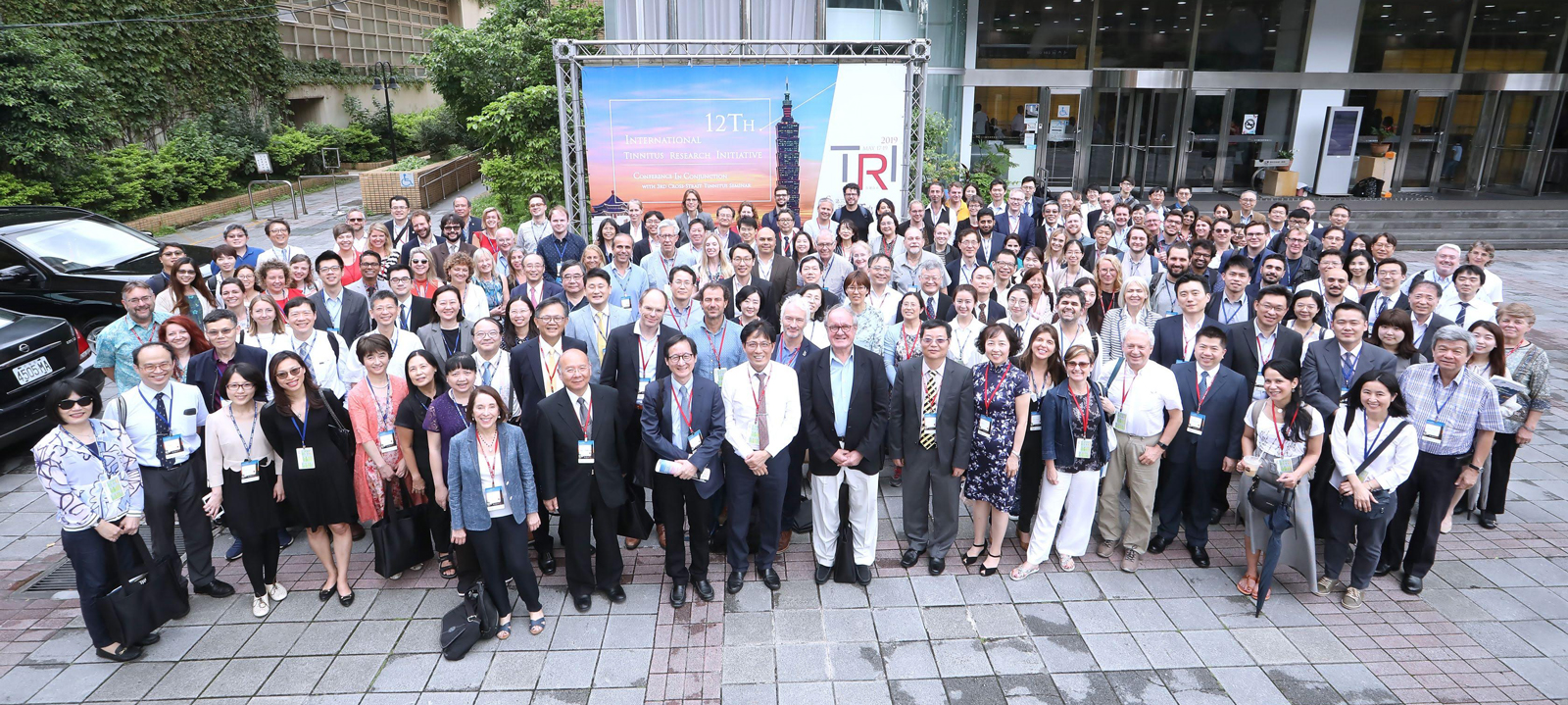
Evolution, Revolution, Stagnation? – Exclusive Insights from #TRI2019
I already shared with you my general impressions of the tinnitus research field in our previous blog post. We had promised to follow up with a bit more detail on what actually went on at the Tinnitus Research Initiative (TRI) 2019 conference in Taipei, so here we go!
Since I spent most of my time conducting video interviews (they are coming soon, I promise!), I could hardly attend any of the talks. Here at Tinnitus Hub we’re all volunteers (who suffer from tinnitus ourselves) and we operate on a negligible budget. This meant I was alone at the conference, running around and trying to do a hundred things at once. It still stresses me out just thinking about it, haha.
And there were so many talks! The program entailed six keynote speeches, and 20 symposia – each of the latter including up to five different speakers.
Hence, even with the gracious help of a group of some PhD students, from the ESIT and TIN-ACT research consortiums, we could only cover a minority of the program. You will find below the students’ reports. A big thank you to all of them for helping out! I think it’s a great example of tinnitus researchers doing direct patient outreach.
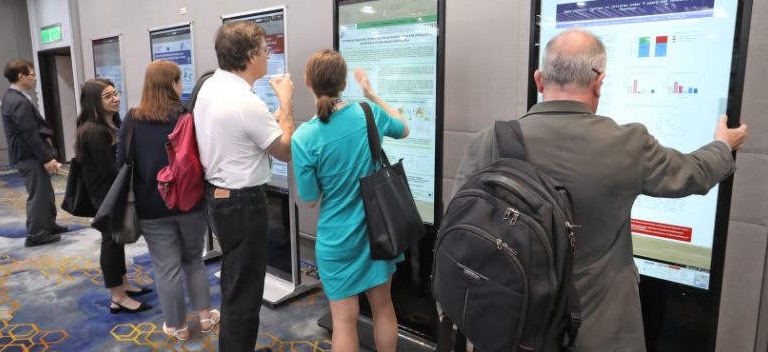
Please note that the below selection of talks was based on a combination of the students’ expertise and availability, as well as a good deal of chance. There’s no particular intent or strategy behind the selection. Time and resources allowing, I would have loved to also cover, for instance, the symposia on Electrophysiology, Pharmacotherapy, Genetics of Tinnitus, and Specific Forms of Tinnitus.
Furthermore, I would have loved to form more of an informed opinion on the quality of the research presented at the conference. But again, I have to admit that due to lack of time and expertise, I must revert to being merely a “conduit” here. I’m just trying to report on what’s out there, and I’ll let you guys make up your minds on whether it’s any good or not.
I guess you can’t have it all. At least not this time. This is why I’m soooo looking forward to the #TRI2020 conference in Vancouver. Instead of just me alone, we plan to be there with a team of volunteers, so that we can really cover and report on all the ins and outs. I can’t wait!
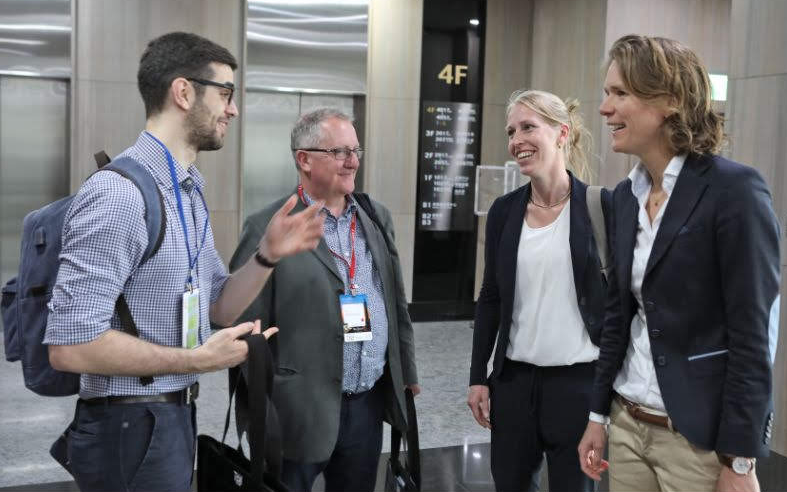
Keynote Speech: Dr. Susan Shore
Brainstem mechanisms in tinnitus
Jorge Simoes
Prof. Dr. Susan Shore is one of the most renowned researchers in the tinnitus field. For decades Prof. Shore and her team investigated the so called “touch-sensitive” neurons in animal models. Those neurons receive input from the face and head, and can modulate the cochlear nucleus, a tinnitus-related brain region. The cochlear nucleus is known to be over-excited in tinnitus patients and reducing this “over-excitation” relieves tinnitus perception. Prof. Shore is using these insights to develop a treatment for tinnitus patients by targeting these “touch-sensitive” neurons. Her presentation in the TRI 2019 consisted of different research she collaborated on throughout the years, which ultimately led to a promising treatment for tinnitus. Prof. Shore’s clarity of though, consistent work at the highest level, and incredible results are inspirational for other researchers and promising for patients. A press release of her work can be found here and here.
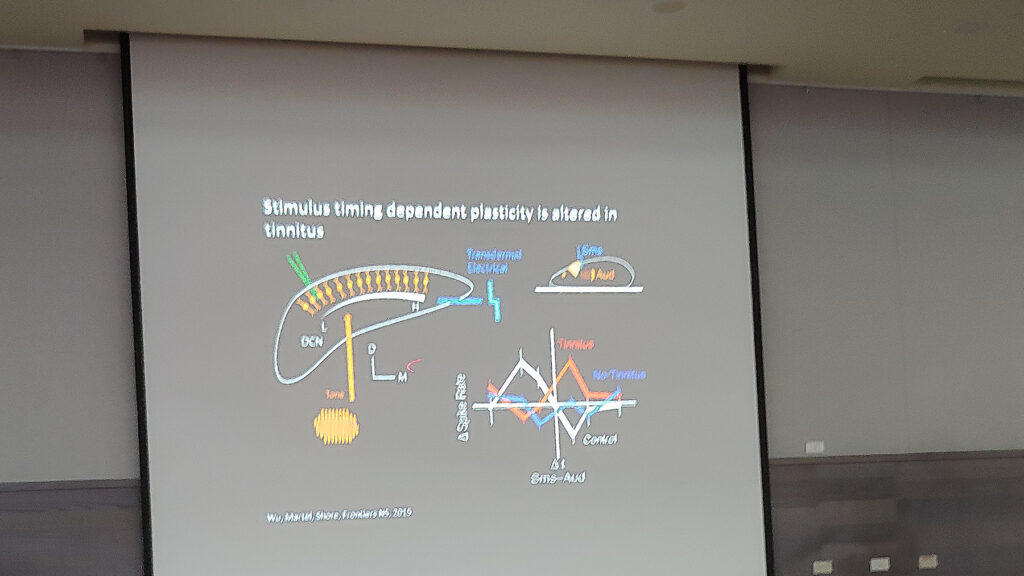
Keynote Speech: Dr. Ana Belen Elgoyhen
Tinnitus: Pharmacological Intervention, What Should We Target?
Gregory Ginnan
TRI 2019 was privileged to host Dr. Ana Belen Elgoyhen of the Laboratory of Physiology and Genetics of Hearing (INGEBI, CONICET, Universidad de Buenos Aires) as a keynote speaker. In her talk, Dr. Elgoyhen laid out the substantial obstacles standing in the way of finding a pharmacological solution to a condition as multifaceted as tinnitus, as well as some of the progress made so far in the field. As we enter the 2020s, life science data continues to increase exponentially, which has directly impacted fields such as systems biology and network pharmacology. By leveraging this pharmacological “big data”, Dr. Elgoyhen and her team in Argentina have begun a systematic search of all drugs that produce tinnitus as a side effect, investigating the relationships between these various drugs and the different mechanisms by which they may cause a ringing of the ears. So far, 250 drugs that produce tinnitus have been identified, along with 1300 links between these drugs and their cellular or molecular targets. Dr. Elgoyhen is hopeful that this approach will allow for the eventual isolation of common proteins and genes that could help scientists reverse engineer a successful pharmacological intervention for tinnitus. Reaching a solution will depend on our ability to interact with and extract meaningful interpretations from this ever-growing amount of big data.
Symposium 1: Epidemiology
Constanze Riha
One in 7 – This represents approximately 75 million people in the EU, who have experienced tinnitus in the last 12 months. Given its high prevalence, the impact on quality of life however does differ between countries in the EU as a pan-European survey reports recently (preliminary results).
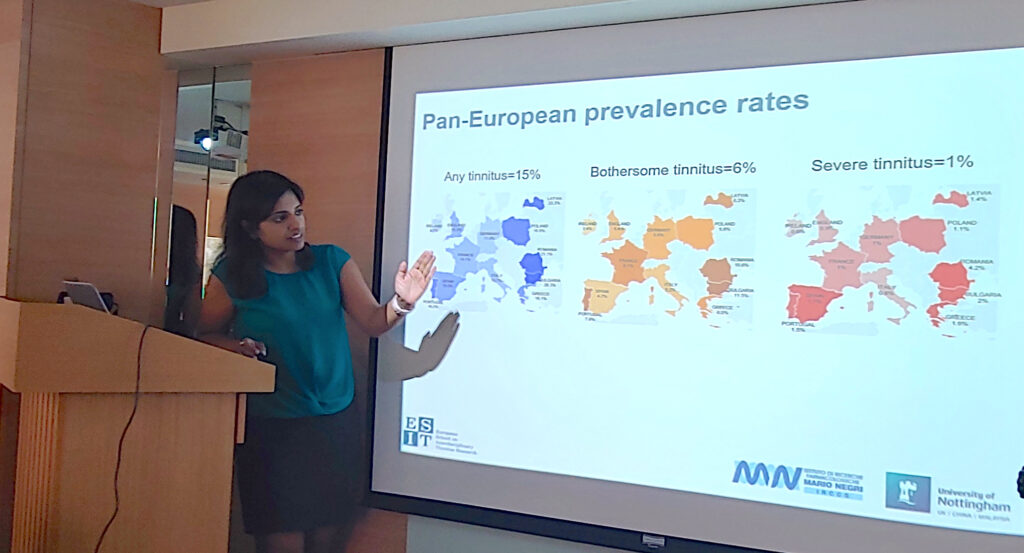
Possible risk factors of tinnitus were observed as being in the age group between 45 and 75 years, as well as years of (work-related) noise exposure which might also lead to hyperacusis (increased sensitivity to certain frequencies and sounds) at the same time. Furthermore, there is an elevated risk in people with a history of chronic ear infection, depression and increased stress. In addition, tinnitus tends to be more prevalent in males than females and in individuals with higher rates of anxiety and poor quality of life compared to those without tinnitus. Moreover, specific personality traits might influence the experience of tinnitus, specifically distress too. Those traits are extraversion and neuroticism. The fist trait seems to be protective, meaning the higher the extraversion the lower the distress, whereas neuroticism is considered a risk factor.
Symposium 2: Animal Models of Tinnitus
Vinay Parameshwarappa
One could sit back and think why we need animal models to study tinnitus. Human brains can of course deviate from animal models, but animal models do give us a pretty good grasp of what is happening in the brain with tinnitus. Studying the changes induced by tinnitus in the auditory system requires access to the brain’s micro-environment. To achieve this, it is necessary to use invasive methods, which cannot be carried out on humans. Hence, animal models become essential to address the scientific questions with regard to ignition and mechanisms of tinnitus.
The animal model session at the conference focused on the potential neuro-physiological mechanisms of tinnitus in the auditory pathway. These studies showed that basic neuroscience is the key to understand the complex network of the brain involved in tinnitus, and to develop potential treatments. Increase of activity in the tinnitus brain is already well-reported in animal models, however the mechanisms that underlie the phenomenon are still unclear. An intriguing study that caught my attention described the chemical changes at the level of neural cells caused by the exposure to loud sound. This study provides the basis for understanding why and when brain activity increases after exposure to loud sound. Decreasing this hyperactivity in the brain may reduce the tinnitus percept.
Some other key messages from the session include: With the optogenetic animal model of tinnitus, the central auditory structures are revealed to play a key role in tinnitus, which is a step forward towards statistical validation of ‘Gap-pre pulse inhibition of the acoustic startle reflex (GPIAS)’, a behavioral model for detection of tinnitus in animals. Finally, the use of functional magnetic resonance imaging is proving an important tool to study the auditory function in animal models.
Symposium 3: Diagnostics
Jorge Simoes
Better diagnostics of tinnitus is a key area of interest for both researchers and clinicians. Here we highlight the main take-home messages from the diagnostics colloquium from the TRI 2019. Dr. Takahasi presented her results on a new form of diagnosis classification for tinnitus patients. This classification took into account three categories: severity of tinnitus, psychological problems, and catastrophic episodes, and was able to identify 5 distinct groups of patients based on their tinnitus severity. The study is available online.
Kostantin Tzriids showed the hearing loss of tinnitus patients around the tinnitus frequency, independent of age, supports the so-called Stochastic Resonance model of tinnitus. More can be read about Stochastic Resonance here, and more about the tinnitus model here.
Annemarie van der Wal presented the clinical characteristics of tinnitus patients with the often-overlooked overlap with temporomandibular disorder. Up to 64% of tinnitus patients also suffer from temporomandibular disorder. Annemarie found out that the prevalence of temporomandibular disorder in tinnitus patients is higher in women than in men, and that temporomandibular disorders influences the scores of distress-related questionnaires like the Tinnitus Functional Index.
Symposium 5: Brain Stimulation
Laure Jacquemin
As the perception of tinnitus involves various areas in the brain, current research focuses on the stimulation of these areas as a treatment for tinnitus. The different brain stimulation techniques use either magnetic or electrical stimulation. Currently, the effectiveness of these techniques is limited to a small number of patients who report an improvement (in other words, responders). Research focuses on how to improve these techniques and to unravel the patient characteristics of responders. For example, the electrical stimulation can use smaller electrodes in order to focus the stimulation on one specific brain area. Magnetic stimulation can be improved by optimizing, for example, the intensity of the stimulation. Bimodal stimulation, on the other hand, is a promising technique in this research area, combining two stimulations. One stimulation results in the optimal brain activity in order to increase the effectiveness of the second stimulation. In the search for the patient characteristics of the responders to these treatments, brain measurements are important and may be able to tell if a patient will respond to the treatment. In brief, tinnitus research is focusing on how to improve brain stimulation techniques and investigating which patients can benefit from this.
Symposium 6: Clinical Research Methodology
Maryam Shabbir
In this symposium, the importance of standardization in tinnitus research was discussed. This is crucial in order for various research results to be compared on the same level and to facilitate development of treatments for tinnitus. The Core Outcome Measures in Tinnitus International Delphi (COMiT’ID) study was discussed, showing a road map of future plans aiming to aid this standardization. The importance of Patient and Public Involvement (PPI) was also discussed. As they are key stakeholders in this research, involving them in research procedures can improve quality of tinnitus research. Ensuring that clinical trials are well-designed, which has not always been the case in the past, is another prerequisite to high-quality research outcomes. Hopefully with better clinical research methodology we will be one step closer to treating tinnitus.
Symposium 07: Pathophysiology of tinnitus
Emilie Cardon
All speakers of this session were invited to shed light on the origins of tinnitus. As the session progressed, this began to look more and more like an issue of the entire brain, as several of the speakers stressed the importance of brain regions beyond the commonly studied auditory cortex. Dr. Jae-Jin Song labeled memory-related areas such as the parahippocampus as quite possibly the most important hub for tinnitus generation. Meanwhile, Prof. Josef Rauschecker dubbed one specific prefrontal region the “hotspot of attention” and illustrated that this region is smaller in tinnitus patients. Dr. Ho Yun Lee proposed to regard these brain peculiarities as possible treatment options. Admitting that conventional treatment methods are not always sufficient, he advocated for the use of more experimental techniques such as neuromodulation. These methods might achieve a slight, but ultimately significant, improvement in the perception of tinnitus. Interestingly, Asian tinnitus patients seem to be more susceptible to the benefits of neuromodulation, although this assumption can and should be tested in larger populations in the future.
Symposium 8: Hearing Aids / Cochlear Implants
Eleni Genitsaridi
This symposium was about the value of sound therapy, hearing aids and implantable devices on tinnitus management. The effect of hearing aids on tinnitus was discussed in many of the symposium presentations. The first speaker, Eui-Cheol Nam, presented a study showing long term tinnitus suppression effects with the use of hearing aids in people with high frequency hearing loss.’ Two of the talks highlighted the benefit of cochlear implantation in patients with tinnitus and single sided deafness. In addition, Annick Gilles showed that in cases where an Auditory Brainstem Implant (ABI) is recommended, it can also lead to significant tinnitus reduction. The symposium finished with Magdalena Sereda’s talk on the Cochrane systematic review about sound therapy using amplification devices and/or sound generators for tinnitus, highlighting the lack of significant data and the need for well-designed randomized controlled studies.
Symposium 10: Hyperacusis/Misophonia
Matheus Lourenco
For many of those who suffer from tinnitus, the terms misophonia and hyperacusis are well known. These terms refer to two conditions which often co-occur with tinnitus. The first, misophonia, refers to the extreme negative reactions such as annoyance, fear, and avoidance of specific sounds such as chewing food or clinking dishes. Hyperacusis, on the other hand, are similar negative reactions that arise from a higher sensitivity to sound volume. In other words, misophonia encompasses negative reactions to specific sounds (at any volume), while hyperacusis refers to the negative reactions to sound intensity (of any sound).
The high prevalence of these conditions together with tinnitus creates yet another hurdle for patients and deserves special attention. Researchers and clinicians from different disciplines from around the world are now focusing on these conditions and their relationship with tinnitus. Although still in its infancy, research and treatment outcomes are promising. Treatments for misophonia and hyperacusis are based on controlled exposure sessions which can be integrated with existing tinnitus treatments such as the Tinnitus Retraining Therapy (TRT) or Cognitive Behavioural Therapy (CBT). Including other conditions, such as misophonia and hyperacusis, into the spectrum of research and treatment for tinnitus follows a comprehensive approach to each individual patient and their unique pathological experience and path to recovery.
Symposium 13: Asian perspectives on tinnitus
Roshni Biswas
Asia has the highest incidence of hearing related problems in the world. This session provided new insights on tinnitus research in Asian countries, therapy measures, patient perspectives, and the effect of cultural differences. A lot of the research results presented were focused on the relationship between migraine and tinnitus. One of the studies showed a reduced impact of chronic tinnitus with the use of menopausal Hormone Replacement Therapy (HRT) in migraine patients. The Asian countries translate and adapt the various tinnitus assessment scales to suit the population. But essentially the same scales are used as in Western countries. If tinnitus severity is rated on a scale ranging from ‘no problem’ to a ‘very big problem’, the distribution of patient population in Asian countries is again very similar to Western countries. However, the patient perspectives vary since they prioritize their problems differently, and this could be largely attributed to the inherent cultural differences.
Symposium 14: Comorbidities of Tinnitus
Maryam Shabbir and Eleni Genitsaridi
This very interesting symposium on the last day of the conference focused on the various tinnitus comorbidities; in other words, conditions that are commonly associated with tinnitus. Understanding how these associated conditions are related to tinnitus is an important part of the tinnitus puzzle. The association between hearing loss and tinnitus was widely discussed in the talks. Other important comorbidities highlighted during the talks were depression, cognitive impairment and sleep disorders. We also heard about ongoing research efforts to understand the impact on tinnitus following platinum-based chemotherapy. Multidisciplinary research collaboration is being done between audiology, oncology and genetics to better understand this type of tinnitus. It could well be that different patient groups require different kinds of treatment, depending on which comorbidities are present. This means it’s crucial to gather more (big) data on how prevalent different comorbidities are in different patient groups.
Symposium 20: Cortical Networks/ Neuroplasticity/ Imaging Studies
Stefan Schoisswohl
The final symposium of the 12th International Tinnitus Research Conference was entirely dedicated to functional and anatomical aspects of the human brain. As we know, tinnitus represents a mismatch of the brain to missing auditory information, which could result from hearing loss or cochlear damages. The brain then reacts to this changed information input and creates a sound perceived as tinnitus. The main focus of this symposium was to provide recent insights in certain changes of the human brain, which are accompanied by this experience. Latest findings in this research area showed that in tinnitus, brain areas are less connected to each other, similarly to elder people. Furthermore, anatomical brain changes, different from people without tinnitus, occur. An interesting part of the symposium covered the commonalities of tinnitus and pain. It was stated that both tinnitus and pain arise from disbalance between the sound or pain input and sound or pain inhibition. Likewise, changes in brain activity after short-term tinnitus suppression via acoustic stimulation were presented and discussed. The symposium gave essential insights into the neural processes behind tinnitus and indicates that we must first sufficiently understand the mechanisms of action for tinnitus in order to find a cure.



2 Comments
So are you saying there will be no cure for tinnitus for 30 years 🙁
Hey Emma, I honestly have no clue when the cure will come. I am quite certain it will come though. That probably doesn’t help you much right now. Best of luck though.
The Time Is Now — Tinnitus Sufferers Take the Lead in Research
By Hazel Goedhart, Director of Tinnitus Hub It was the moment I had been working towards for years; presenting at the Tinnitus …
When Will We Finally Get a Voice in Tinnitus Research?
By Hazel Goedhart, Director of Tinnitus Hub Imagine being invited to join a group holiday, only to find out you will be travelling …
Here’s Why the Jury’s Still Out on Lenire
By Hazel Goedhart, Director of Tinnitus Hub You’re suffering from tinnitus and you’ve heard of this new treatment called …